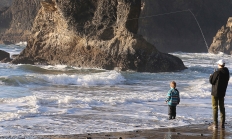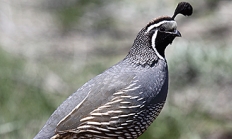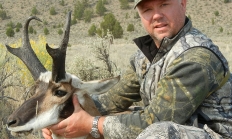
Search myodfw.com
Whether you ’re turkey hunting with a bow or shotgun, you’ll need to know when to take the shot. If you’re using a shotgun, the best shot will be at the head, preferably when it’s outstretched away from the bird’s body. Bowhunters will want to know something about turkey anatomy so they’ll recognize when they have a clear kill shot to a vital organ. Make sure it’s safe to shoot In addition to having a good shot at a bird, you’ll want to make sure there are no other hunters, livestock or other turkeys nearby that you could hit by

Shooting a target while standing up at the range is a lot different from shooting a turkey while sitting in a ground blind. When practicing for a hunting trip, recreate your shooting scenario. Whether it will be standing, sitting, kneeling, and in or out of a ground blind. Shooting a turkey There ’s no substitute for practicing in conditions that closely resemble those you’ll be hunting in, and this is especially true for bowhunters looking to bag a turkey. Turkeys are nervous birds with very small kill zones, so accurate shot placement is critical for getting a quick, clean kill


For hunters, spring marks the beginning of the “turkey year” so let’s trace turkey activity through the year beginning in the spring. Spring nesting season The peak of the breeding season has already passed by the time the spring turkey hunting season opens April 15. Toms will breed with multiple hens throughout the spring and early summer. As the eggs develop, the hen will build a ground nest in a place with good cover and close to good brood habitat, which is normally an opening in the forest cover. Once she starts laying eggs, a hen will lay one egg

Rogue Unit general archery hunters: portion of unit closed on opening weekend
CENTRAL POINT, Ore. – The Rogue-Siskiyou National Forest is temporarily closing the Huckleberry Mountain area in the High Cascades Ranger District Aug. 22-31 for Tribal ceremonial purposes. Rogue Unit general archery hunters should be aware of the closure over the archery opening weekend, Aug. 30-31…


Trout fishing opportunities abound in this zone, known for its high desert climate, sage-covered canyons, glacial peaks and mountain lakes. Anglers will find year-round trout fishing in the Deschutes, Metolius, Fall and Crooked rivers, while several central Oregon lakes and reservoirs are renowned for their trout and kokanee fishing – and their beauty. The Hood and lower Deschutes – both tributaries of the Columbia River – offer high desert fishing for Chinook salmon and summer steelhead.
A dozen great rivers pour out of the Coast Range Mountains into tidal bays that welcome runs of salmon and steelhead. Bays are the year-round home to marine perch, rock fish, crabs and clams, while other species come and go with the seasons and tides. A handful of ponds dot the forested slopes, and there are dozens of dune lakes— many stocked with rainbow trout, and some harboring largemouth bass, perch, crappie and brown bullhead.
Abundant rainfall feeds the massive Willamette River watershed, tamed by a system of reservoirs that are stocked annually with hundreds of thousands of rainbow trout. Some of these reservoirs also grow trophy-size largemouth and smallmouth bass, as well as bluegill, brown bullhead and crappies. Smaller lakes and ponds nearer the valley floor provide springtime trout fishing close to home. Salmon and steelhead navigate the Willamette River and its tributaries, many of which are also home to rainbow and cutthroat trout.
Wide open spaces, wild windy places, and extreme temperatures characterize Oregon’s largest, most remote fishing zone. Redband trout are native to its rivers and streams, including the Williamson, Malheur and Chewaucan. Brown and hatchery rainbow trout can grow to trophy-size in many of its lakes and reservoirs, many of which also feature crappie, yellow perch and bass.


ODFW seeks applicants for two positions on the State Access and Habitat Program Board
SALEM, Ore.—Do you have a love of hunting and passion for wildlife conservation? Are you knowledgeable about forestry and/or agriculture? If so, there are vacancies for a Landowner Representative and a Hunter Representative on the Access & Habitat (A&H) Board. Applications are being accepted by the…
There is year-round salmon, steelhead, trout and smallmouth bass in the Southwest Zone. Rainbow trout are stocked in the upper Rogue River and in lakes nestled among fir forests and wind-swept dunes. Big reservoirs provide fishing for trout and for thriving populations of largemouth bass, catfish, perch and crappie. Coastal bays serve as gateways to rich offshore reef fisheries, and miles of public beach allow anglers to fish for surfperch against a backdrop of rugged capes.

California quail are the most widely distributed upland game birds in Oregon. Most easily recognized by the comma-shaped, black, plume, or "topknot," which bends forward and is larger on the male. It has been a resident statewide since the early 1900s, except for most forests of the north Coast Range and west Cascades; it is generally absent along the coast north of Coos Bay. California quail is also absent from high-elevation areas of the east Cascade range. They are common residents in rural and even some suburban areas, particularly in eastern Oregon where many coveys gather at feeding stations during


Oregon requires all hunters under the age of 18 to complete a hunter safety education course before hunting in the state. Upon course completion, students will receive a temporary Hunter Safety certification card to be carried while hunting in Oregon until a permanent card is received in the mail to replace it. Hunters over 18 are encouraged to take the online education course, as it may be required for out of state hunts. Note: Youth under the age of 9 may struggle with the course material and may not have the physical strength needed to safely handle a firearm during


